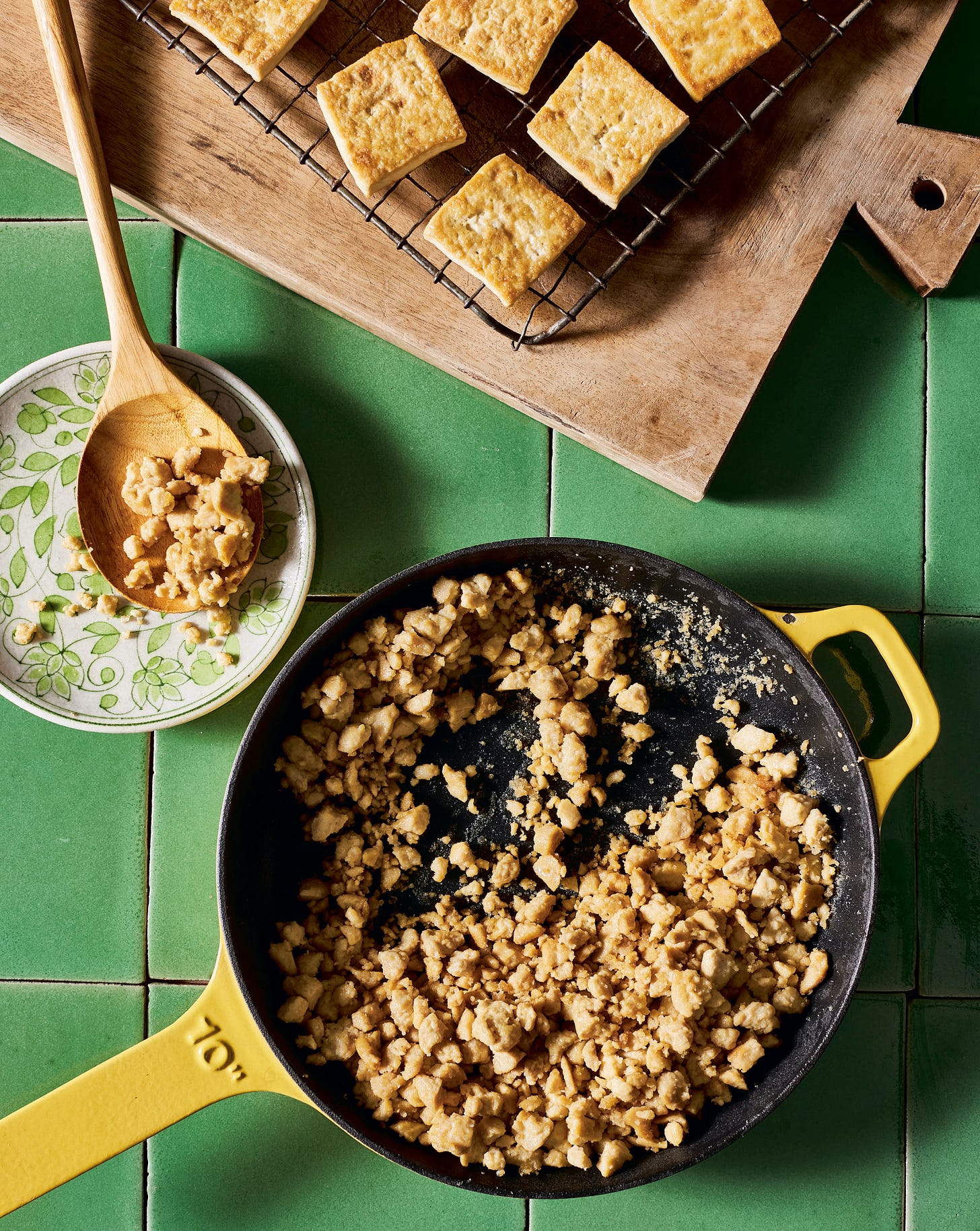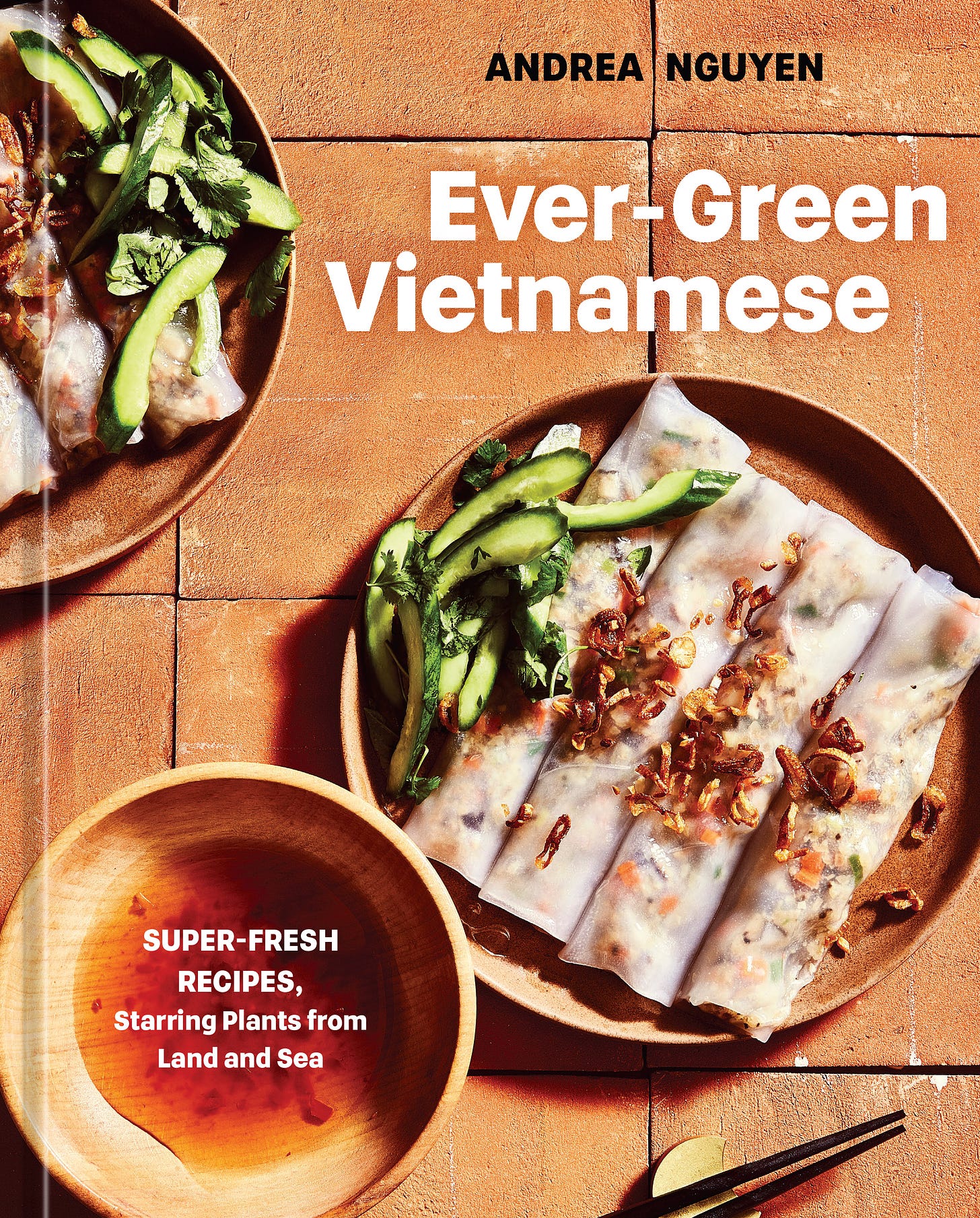Thịt Bằm Chay (Umami Tofu Crumbles) and Hành Phi (Fast-Fried Shallots)
from Andrea Nguyen's 'Ever-Green Vietnamese'
Alternatives to ground-meat products are formulated for certain uses, such as hamburgers. Given that lighter-flavored ground pork is thego-to for many Viet foods, I developed this natural, inexpensive, and versatile substitute (pictured opposite, at bottom) for thịt bằm (mincedmeat). It’s handy for snacks, fried rice, bao, and more.
Coating nubs of super-firm tofu with coarsely ground supermarket rice flour creates the bumpy texture of cooked ground meat. This is afamily-friendly recipe. Recipe tester Jenny Sager’s one-year-old enjoyed helping crumble the tofu.
Thịt Bằm Chay (Umami Tofu Crumbles)
Makes 1 ½ cups
8 oz super-firm tofu
1 Tbsp white or brown rice flour
1⁄4 tsp MSG, 1⁄2 tsp Asian mushroom seasoning, or 1 1⁄2 tsp nutritional yeast
1⁄8 to 1⁄4 tsp fine sea salt (less if using MSG or mushroom seasoning)
1 Tbsp fish sauce (store-bought or vegan version, page 29), Maggi Seasoning sauce, Bragg Liquid Aminos, or soy sauce
1 1⁄2 Tbsp neutral oil (such as canola or peanut)
Crumble and season the tofu
Blot the tofu dry with a dish towel, then cut or break it into approximately 1-inch chunks. Over the sink, in batches of one or two chunks, give them a squeeze with one hand to slightly mush them, flicking excess water into the sink. (Instead of using bare hands, you may re-use the dish towel to squeeze andcrush the tofu.) Using your fingers, crumble the tofu into smaller pieces that resemble very coarsely ground meat (think chili grind with some tiny bits),dropping it into a medium bowl.
Sprinkle the rice flour, MSG, and salt onto the tofu, then stir and toss to coat. Stir in the fish sauce and 1 Tbsp of the neutral oil. Let sit for 5 minutes.
Fry the crumbles
In a 10-inch nonstick, carbon-steel, or cast-iron skillet over medium heat, warm the remaining 11⁄2 tsp neutral oil. Add the seasoned tofu and give things a stir.When you hear gentle sizzling in the skillet, lower the heat slightly and cook the tofu for 5 to 7 minutes, stirring frequently. As the tofu cooks, the jaggedpieces cohere to resemble bumpy clusters of ground meat; scrape the spatula against the pan’s rim to return any sticking bits to the mixture. The tofu willdarken or brown a bit, depending on the liquid seasoning chosen (Maggi, Bragg, and soy sauce darken more than fish sauce). You can keep cooking it further,but it may dry up too much. Aim for moist crumbles. Remove from the heat and let cool for about 5 minutes to further meld the flavors before using, or let cool completely and refrigerate for up to 1 week.
Notes
This recipe yields 8 oz from one-half package of tofu, so use leftover tofu for the wontons on page 89. Or cook up a double batch in a 12-inch skillet.
Caramelized slices of fried shallot adorn many Vietnamese dishes, lending sweet pungent notes. Ardent cooks, like my mother, fry a lot of shallots in advance, but they’re never as good as when freshly made. Shallots cultivated abroad tend to be moister than ones in Vietnam, which means frying takes longer.
I’ve tried shortcuts, such as frying sliced dried shallots imported from Vietnam, but unfortunately they lack flavor. The Maesri brand of fried shallots from Thailand is good and so are European-made fried onions from Trader Joe’s and Lars. That said, when I want to send a dish over the top, I fry a small batch of hành phi. Microwaving the shallots first quickly removes some moisture, so you spend less time frying (see Note if you don’t use a microwave). When frying a double batch, use a 10-inch skillet.
Hành Phi (Fast-Fried Shallots)
Makes 3 Tbsp fried shallots and 2 1⁄2 Tbsp shallot oil
Brimming 1⁄3 cup thinly sliced shallots
3 Tbsp neutral oil (such as canola or peanut)
Partially dry the shallots
Line a microwavable plate with a paper towel. Separate the shallots into pieces (you may have rings or half circles), dropping them on the paper towel; it’s okay to leave itty-bitty, tight pieces intact. Spread out the shallots, overlapping them as needed. Microwave on high power for 60 to 90 seconds, until the slices are roughly half their original size. Expect steam and light brown streaks on some pieces.
Remove the paper towel and shallots from the plate and let cool to room temperature, 2 to 3 minutes. You can gently fluff them with your fingers to further separate the pieces as they cool.
Fry, cool, and crisp
Set a fine-mesh strainer in a medium bowl and place near the stove.
In a 1- to 1 1⁄2-qt saucepan, combine the neutral oil and shallots, stirring gently a few times to combine. Set over medium-low heat and, after gentle sizzling begins, let the shallots cook for about 4 minutes, stirring or swirling frequently for even cooking. As the frying action ramps up and if you fear it getting out of hand, turn down the heat slightly to better monitor progress; it’s better to fry longer and gentler.
When roughly half the shallot pieces are golden brown, remove the pan from the heat and continue stirring and swirling as the shallots keep darkening. After about 30 seconds, when most of the shallots are golden, pour them into the prepared strainer. Let cool for about 3 minutes, until crisp (shake the strainer and the shallot pieces should rattle), before using. If the shallot pieces aren’t crisp, briefly and carefully re-fry them in the oil. Save the strained fragrant oil for other dishes such as fried rice (see page 67).
Notes
Equipment If you don’t have a microwave, pat the cut shallots with a paper towel to remove moisture and fry a little longer. You’ll have less oil remaining.
Lifespan These fried shallots are best the day they are made. When they’re covered with parchment paper and kept overnight at room temperature, their flavor dulls slightly. If they soften, briefly re-fry with a touch of neutral oil over medium-low heat.
Reprinted with permission from Ever-Green Vietnamese: Super-Fresh Recipes, Starring Plants from Land and Sea by Andrea Nguyen, copyright © 2023. Published by Ten Speed Press, an imprint of Penguin Random House.
Photographs copyright © 2023 by Aubrie Pick





